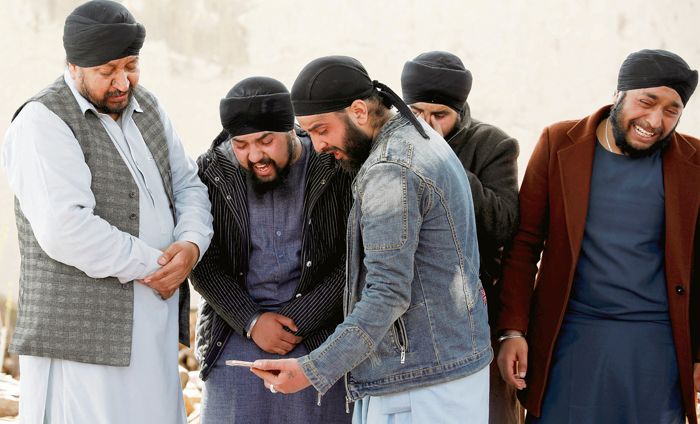
Horrific attack: The presence of minorities in Afghanistan has rattled terror elements.
Lt Gen Sanjiv Langer (retd)
Lt Gen Sanjiv Langer (retd)
Former Deputy Chief of Defence Staff
As the images of the recent terrorist attack on the Shor Bazaar Gurdwara in Kabul haunt us, the ascendant currency of terror in Afghanistan comes to fore. The attack has left an unforgiving impact on the assessed 300 Sikh families remaining in Kabul. Its wider message and implications need consideration. Executed on the conjoint timing of the Hindu New Year and the Shaheedi Divas of Bhai Subeg Singh (18th-century martyr), its messaging is a clear warning to the Sikh and Hindu minorities in Afghanistan on their continued presence. In conjunction with the March 6 attack on the Shia community, it is also a continuing proclamation by the terrorist organisations on the future outcomes for all minorities.
When it comes to attacks being claimed by the Islamic State-Khorasan (IS-K) and the Taliban distancing themselves, a nuanced view is needed. Though the Taliban ceasefire ended earlier this month, it is in their interest to appear distanced from attacks in view of their recent legitimacy. The IS-K has a clear wider agenda, which includes J&K.
Facilitating and furthering the attack on the gurdwara by the Taliban, through the IS, is merely committing murder with a borrowed knife. The Taliban have a malicious history of persecution of Sikhs and Hindus in Afghanistan. They would have no hesitation in ‘mothering’ this attack. The name of the Haqqani group is also doing the rounds. It must be remembered that the Haqqani brothers and their cadre are deeply intertwined with the Taliban. The Haqqani faction has been the preferred instrument of the Pakistan ISI for targeting Indian assets and entities in Afghanistan.
While there is a family of terrorist entities operating in the region, the Afghan Taliban are today principally the controller of the ‘space’. The rise to legitimacy and centrality of this vicious non-state actor compels us to look at their persona as Afghanistan lurches forward. ‘The West has the watches but we have the time,’ said Ashoor, a Taliban leader, a decade ago. Today, we can only affirm this view. With a stranglehold in the Afghan-Pakistan border region (Af-Pak) and an envious history of survival and tenacity, their politico-military signature is unassailable. Their ominous success is, however, clearly representative of a collective failure of decades of politico-military intervention. Equally, they are a grim reminder of the consequences of playing with powerful entities for short-term gains when unable to control the outcomes.
Essential to this non-state actor’s status today is the fact that despite being battered and assaulted, they have remained undefeated. Equally significant is the fact that the Taliban retained the initiative and were able to launch strikes over a wide expanse of Afghanistan. After the Pakistan Army’s attacks on the Lahore Lal Masjid in July 2007 and the formation of the Tehreek-e-Taliban (TTP) targeting Pakistan, the currency and strategic value of the Taliban fraternity heightened. Undoubtedly, the tenacious and ruthless fighting qualities of the region come to the fore. History has shown that it has been the graveyard of several empires and powers.
Equally important, however, is the agenda of Pakistan’s establishments (army, ISI and polity in part). To this end, the concept of Pakistani strategic space needs focus. It is not a static formulation, solely locked in with the Indian perceived threats. Their fears are heavily accentuated by the history of Afghan claims over all Pashtun areas and Baluchistan. They view the region with the potential of giving oxygen to any irredentism in Pakistan.
For the Afghan Taliban, the combination of a core geographic area, an ability to strike with impunity, Pakistan’s committed loyalty, and an inflexible political agenda, put them on the high table. Narcotics, manpower, weapons and a resolute will to fight have secured their longevity.
The February 29 US-Taliban agreement, brokered by Pakistan, aimed at an ultimate political settlement in Afghanistan, seems stillborn. With two Presidents in Afghanistan, the state is in paralysis. While the US may back President Ashraf Ghani, Abdullah Abdullah, who carries the weight of the Afghan minorities and the backing of all erstwhile Northern Alliance Commanders, cannot be ignored. The Taliban has recommenced attacks since March 2. As evidenced by the attack on the gurdwara, targeting of minorities has been enhanced. President Ghani has refused to release 5,000 militant prisoners, as demanded by the Taliban, opting for a phased release. Pakistan is stretching every sinew to push the agreement and satisfy the Taliban. They see this as the only hope for peace on their western frontier. This is also so since the Afghan Taliban have agreed to joint cross-border operations to eliminate the TTP (IS-K), based in east Afghanistan. Equally painful, Pakistan has to shut down the Jaish-e-Mohammed and part with the Haqqani network, both old terrorist executors for the Pakistan establishment.
This tantalising cocktail makes it evident, that the future of the politico-military stability in the region is remote. Pakistan’s western frontier peace dream has too many detractors. A dissatisfied autonomous Taliban can look any way. Years of Pakistani army operations in Waziristan (north-west Pakistan) have given rise to an antagonistic and dissatisfied populace. The TTP has shown tenacity and moved from the Waziristan territories in Pakistan to Kunar and Nurestan in Afghanistan. This entity, now an affiliate with the IS-K, is also being closely drawn into the Taliban agendas.
Reading some headlines, it is easy to imagine that all will be well. Far from it. The Taliban are a violent and unforgiving entity, centred on the agenda of their male leaders and fighters. They seek complete domination. Though Pakistan is pushing their agenda, Pashtuns and Punjabis go up to a point. The Taliban and the TTP (IS-K) will have no hesitation in turning on Pakistan when unplanned outcomes manifest. As the Taliban are now a legitimate entity and the only cohesive fighting force, a greater share of the economy, formal and informal, will be theirs. This will further their autonomy. They disregard the government of Afghanistan. Now, they will do the same with Pakistan. It must be understood that when targeting is involved, the terrorist entities in Afghanistan have several faces to choose from. The umbilical cord tying them is the fact that they are largely Pashtuns or Pashtun-related, tied by the code of Pashtunwali (Code of life).
From their client roots in the Mujaheedin to their present autonomy marks a definitive trajectory for the Taliban. It is a path strewn with the legitimate aspirations of the Afghan populace. Largely, an outcome of out-of-area machinations, with out-of-area priorities, and little concern for the citizenry. Continued instability and anarchy favour only the Taliban.
The spirited and rapid response of the Afghan security forces to the attack on the gurdwara needs great appreciation. It only reinforces the fact that when the global community had the time, we should have invested much more in the Afghan National Army, and the Afghan National Police. As Afghanistan convulses again, we need to consider the irony that lethal non-state actors hold the key to future peace and prosperity in Afghanistan.
Join Whatsapp Channel of The Tribune for latest updates.




























